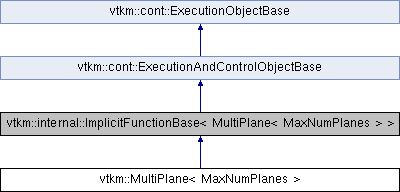Implicit function for a MultiPlane. More...
#include <ImplicitFunction.h>

Public Types | |
| using | Scalar = vtkm::FloatDefault |
| using | Vector = vtkm::Vec< Scalar, 3 > |
Public Member Functions | |
| MultiPlane ()=default | |
| template<vtkm::IdComponent SrcMaxPlanes> | |
| MultiPlane (const MultiPlane< SrcMaxPlanes > &src) | |
| template<vtkm::IdComponent SrcMaxPlanes> | |
| MultiPlane & | operator= (const MultiPlane< SrcMaxPlanes > &src) |
| void | AddPlane (const Vector &origin, const Vector &normal) |
| vtkm::Plane | GetPlane (int idx) |
| vtkm::VecVariable< vtkm::Plane, MaxNumPlanes > | GetPlanes () const |
| Scalar | Value (const Vector &point) const |
| Evaluate the value of the implicit function. More... | |
| Vector | Gradient (const Vector &point) const |
| Evaluate the gradient of the implicit function. More... | |
Private Attributes | |
| vtkm::VecVariable< vtkm::Plane, MaxNumPlanes > | Planes |
Detailed Description
template<vtkm::IdComponent MaxNumPlanes>
class vtkm::MultiPlane< MaxNumPlanes >
Implicit function for a MultiPlane.
A MultiPlane contains multiple planes. Each plane is defined by a point and a normal to the plane. MaxNumPlanes specifies the maximum number of planes it can hold. We can assign another MultiPlane with a smaller number of planes to the current MultiPlane.
Member Typedef Documentation
◆ Scalar
| using vtkm::MultiPlane< MaxNumPlanes >::Scalar = vtkm::FloatDefault |
◆ Vector
| using vtkm::MultiPlane< MaxNumPlanes >::Vector = vtkm::Vec<Scalar, 3> |
Constructor & Destructor Documentation
◆ MultiPlane() [1/2]
|
default |
◆ MultiPlane() [2/2]
|
inline |
Member Function Documentation
◆ AddPlane()
|
inline |
◆ GetPlane()
|
inline |
◆ GetPlanes()
|
inline |
◆ Gradient()
|
inline |
Evaluate the gradient of the implicit function.
The Gradient() method for an implicit function takes a vtkm::Vec3f and returns a vtkm::Vec3f representing the pointing direction from the implicit function's shape. Gradient calculations are more object shape specific. It is advised to look at the individual shape implementations for specific implicit functions.
◆ operator=()
|
inline |
◆ Value()
|
inline |
Evaluate the value of the implicit function.
The Value() method for an implicit function takes a vtkm::Vec3f and returns a vtkm::FloatDefault representing the orientation of the point with respect to the implicit function's shape. Negative scalar values represent vector points inside of the implicit function's shape. Positive scalar values represent vector points outside the implicit function's shape. Zero values represent vector points that lie on the surface of the implicit function.
Member Data Documentation
◆ Planes
|
private |
The documentation for this class was generated from the following file:
 1.8.17
1.8.17